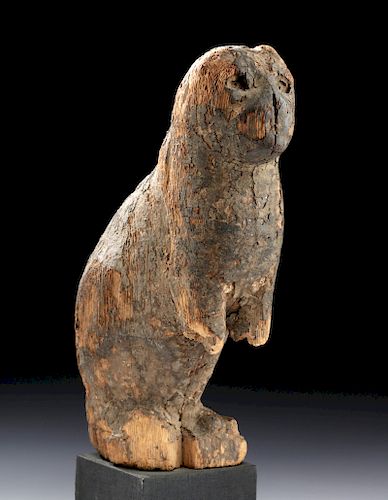Rare Egyptian Wood / Stucco Sarcophagus of a Cat
Lot 14a
About Seller
Artemis Fine Arts
686 S Taylor Ave, Ste 106
Louisville, CO 80027
United States
Selling antiquities, ancient and ethnographic art online since 1993, Artemis Gallery specializes in Classical Antiquities (Egyptian, Greek, Roman, Near Eastern), Asian, Pre-Columbian, African / Tribal / Oceanographic art. Our extensive inventory includes pottery, stone, metal, wood, glass and textil...Read more
Estimate:
$3,000 - $4,500
Absentee vs Live bid
Two ways to bid:
- Leave a max absentee bid and the platform will bid on your behalf up to your maximum bid during the live auction.
- Bid live during the auction and your bids will be submitted real-time to the auctioneer.
Bid Increments
| Price | Bid Increment |
|---|---|
| $0 | $25 |
| $300 | $50 |
| $1,000 | $100 |
| $2,000 | $250 |
| $5,000 | $500 |
| $10,000 | $1,000 |
| $20,000 | $2,500 |
| $50,000 | $5,000 |
| $100,000 | $10,000 |
| $200,000 | $20,000 |
About Auction
By Artemis Fine Arts
Sep 26, 2019
Set Reminder
2019-09-26 10:00:00
2019-09-26 10:00:00
America/New_York
Bidsquare
Bidsquare : Exceptional Day 1: Antiquities & Asian Art
https://www.bidsquare.com/auctions/artemis-gallery/exceptional-day-1-antiquities-asian-art-4437
Day 1 of an important 2-day auction featuring exceptional, museum-worthy examples of Egyptian, Greek, Etruscan, Roman, Viking, Russian, Near Eastern, as well as Asian Art from China, Japan, Thailand, Vietnam, Burma and India. Artemis Fine Arts info@artemisfinearts.com
Day 1 of an important 2-day auction featuring exceptional, museum-worthy examples of Egyptian, Greek, Etruscan, Roman, Viking, Russian, Near Eastern, as well as Asian Art from China, Japan, Thailand, Vietnam, Burma and India. Artemis Fine Arts info@artemisfinearts.com
- Lot Description
Egypt, Late Dynastic Period, 26th Dynasty, ca. 664 to 525 BCE. A hand-carved wooden sarcophagus, composed of two vertically-split halves, depicting a petite cat seated upon its hind legs atop an integral rectangular plinth. The cat has nicely defined features such as protruding front legs, a rounded back crest, and remains of original white gesso decorations, and the interior of the sarcophagus can be seen when looking through the verso. The narrow face bears a pair of recessed eyes, a broad nose above a tapered chin, and a pair of perky ears. A wonderful example of one of Egypt's most symbolically significant animals. Size: 4.9" L x 2.875" W x 7.625" H (12.4 cm x 7.3 cm x 19.4 cm); 9.625" H (24.4 cm) on included custom stand.
Thousands of mummified cats and kittens were given as offerings at temples in honor of Bastet, the cat god associated with domesticity, fertility, childbirth, and, above all, cats. Beyond the goddess, cats were honored and protected in Egyptian society. Famously, Herodotus wrote that men would protect cats from fire, and that when a cat died, a household would go into mourning as if a human member of the family had died, shaving their eyebrows to signify their loss. It was immediately before this Late Dynastic Period that worship of Bastet became immensely popular, and her chief center of worship, Bubastis, became a great city, and Herodotus, visiting the city in 450 BCE, described a great festival dedicated to her.
Provenance: private J.H. collection, Beaverton, Oregon, USA; ex-Galerie Eberwein, Germany; ex-private German collection, bought in Egypt by the parents of the previous owner between 1950 and 1960, purportedly found in Thebes at the Valley of the Kings
All items legal to buy/sell under U.S. Statute covering cultural patrimony Code 2600, CHAPTER 14, and are guaranteed to be as described or your money back.
A Certificate of Authenticity will accompany all winning bids.
We ship worldwide and handle all shipping in-house for your convenience.
#149673Losses to tail and back end, areas of front legs, integral plinth, and ears as shown. Chipping to original gesso decorations, with abrasions and nicks to head, body, legs, and plinth, and softening to some finer details commensurate with age. Nice traces of original gesso throughout.Condition
- Shipping Info
-
All shipping is handled in-house for your convenience. Your invoice from Artemis Gallery will include shipping calculation instructions. If in doubt, please inquire BEFORE bidding for estimated shipping costs for individual items.
-
- Buyer's Premium



 EUR
EUR CAD
CAD AUD
AUD GBP
GBP MXN
MXN HKD
HKD CNY
CNY MYR
MYR SEK
SEK SGD
SGD CHF
CHF THB
THB














